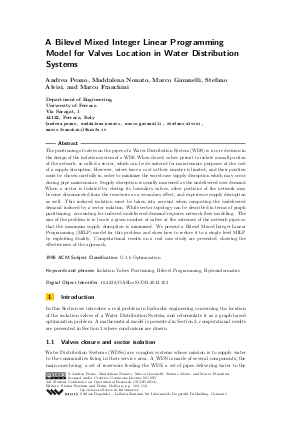A Bilevel Mixed Integer Linear Programming Model for Valves Location in Water Distribution Systems
Authors Andrea Peano, Maddalena Nonato, Marco Gavanelli, Stefano Alvisi, Marco Franchini
-
Part of:
Volume:
3rd Student Conference on Operational Research (SCOR 2012)
Part of: Series: Open Access Series in Informatics (OASIcs) - License:
 Creative Commons Attribution-NonCommercial-NoDerivs 3.0 Unported license
Creative Commons Attribution-NonCommercial-NoDerivs 3.0 Unported license
- Publication Date: 2012-06-26
File

PDF
OASIcs.SCOR.2012.103.pdf
- Filesize: 416 kB
- 10 pages
Document Identifiers
Subject Classification
Keywords
- Isolation Valves Positioning
- Bilevel Programming
- Hydroinformatics
Metrics
- Access Statistics
-
Total Accesses (updated on a weekly basis)
0Document
0Metadata
Abstract
The positioning of valves on the pipes of a Water Distribution System (WDS) is a core decision in the design of the isolation system of a WDS. When closed, valves permit to isolate a small portion of the network, so called a sector, which can be de-watered for maintenance purposes at the cost of a supply disruption. However, valves have a cost so their number is limited, and their position must be chosen carefully in order to minimize the worst-case supply disruption which may occur during pipe maintenance. Supply disruption is usually measured as the undelivered user demand. When a sector is isolated by closing its boundary valves, other portions of the network may become disconnected from the reservoirs as a secondary effect, and experience supply disruption as well. This induced isolation must be taken into account when computing the undelivered demand induced by a sector isolation. While sector topology can be described in terms of graph partitioning, accounting for induced undelivered demand requires network flow modeling. The aim of the problem is to locate a given number of valves at the extremes of the network pipes so that the maximum supply disruption is minimized. We present a Bilevel Mixed Integer Linear Programming (MILP) model for this problem and show how to reduce it to a single level MILP by exploiting duality. Computational results on a real case study are presented, showing the effectiveness of the approach.
Cite As Get BibTex
Andrea Peano, Maddalena Nonato, Marco Gavanelli, Stefano Alvisi, and Marco Franchini. A Bilevel Mixed Integer Linear Programming Model for Valves Location in Water Distribution Systems. In 3rd Student Conference on Operational Research. Open Access Series in Informatics (OASIcs), Volume 22, pp. 103-112, Schloss Dagstuhl – Leibniz-Zentrum für Informatik (2012)
https://doi.org/10.4230/OASIcs.SCOR.2012.103
BibTex
@InProceedings{peano_et_al:OASIcs.SCOR.2012.103,
author = {Peano, Andrea and Nonato, Maddalena and Gavanelli, Marco and Alvisi, Stefano and Franchini, Marco},
title = {{A Bilevel Mixed Integer Linear Programming Model for Valves Location in Water Distribution Systems}},
booktitle = {3rd Student Conference on Operational Research},
pages = {103--112},
series = {Open Access Series in Informatics (OASIcs)},
ISBN = {978-3-939897-39-2},
ISSN = {2190-6807},
year = {2012},
volume = {22},
editor = {Ravizza, Stefan and Holborn, Penny},
publisher = {Schloss Dagstuhl -- Leibniz-Zentrum f{\"u}r Informatik},
address = {Dagstuhl, Germany},
URL = {https://drops.dagstuhl.de/entities/document/10.4230/OASIcs.SCOR.2012.103},
URN = {urn:nbn:de:0030-drops-35519},
doi = {10.4230/OASIcs.SCOR.2012.103},
annote = {Keywords: Isolation Valves Positioning, Bilevel Programming, Hydroinformatics}
}
